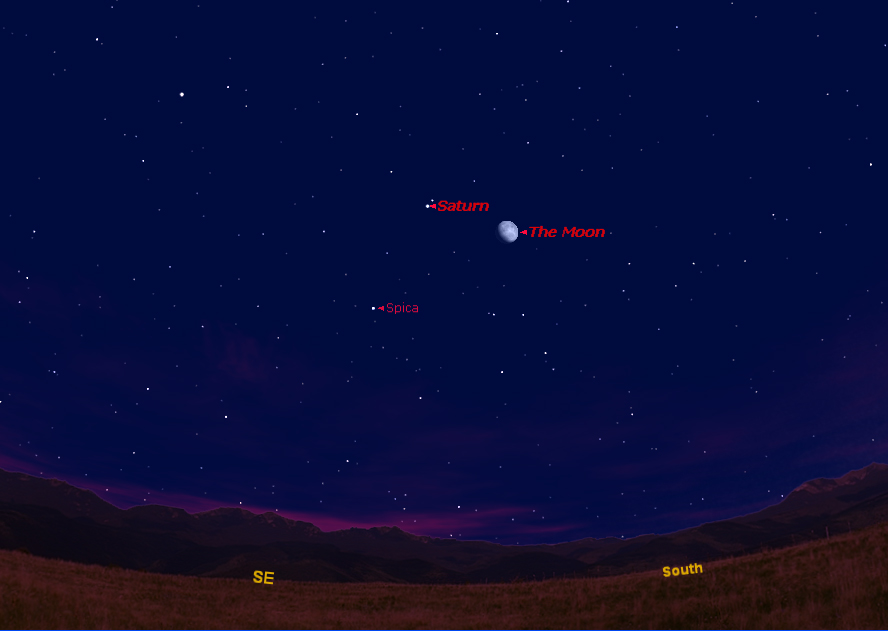
If you've been watching the night sky these past few weeks and gazed almost due south and about halfway up in the sky, you likely noticed two bright "stars" even from brightly lit cities. The brighter of the two is not really a star at all, but a planet: Saturn.
Glowing sedately with a steady yellow-white hue, Saturn is visible in the night sky right on into the wee hours of the morning before it sets. This weekend, the ringed planet will appear in a triangle pattern with the moon and a bright star.
Here's how the Saturn triangle will work:
Situated below and to Saturn's left is the bluish star Spica, in the constellation Virgo, the 16th brightest star in the sky, which is located 260 light-years from Earth. Spica is about eight times larger than our sun and nearly 2,300 times brighter.
During a three-night span of Friday, Saturday and Sunday, a third celestial object will join in the scene: the moon. The sky map of Saturn, the moon and Spica here shows their appearance Saturday night.
At a distance of about 225,000 miles (362,000 kilometers) the moon will appear to sweep past the planet and star rather rapidly. The moon, in fact, appears to move its own width per hour to the east (left) relative to Saturn and Spica. As a result, the scene between this trio will appear to change noticeably from night to night. [Video: Moon and Planet Alignments through June]
Shifting Saturn triangle
Get the Space.com Newsletter
Breaking space news, the latest updates on rocket launches, skywatching events and more!
On Friday night (May 13), the moon, Saturn and Spica will form a broad triangle.
The moon will be a waxing gibbous spectacle, roughly midway between its "half" or first quarter phase (which occured May 10) and full phase (May 17). Saturn will appear well above and to the left of the moon, while Spica will be positioned far to the left of both.
On Saturday evening (May 14), the scene will have changed radically. Now, the moon has moved down to sit just off to the right of Spica. Saturn will stand well above and a bit to the right of both.
The configuration now resembles a long, narrow isosceles triangle, with the "legs" of the triangle measuring about 14 degrees across. For comparison, your clenched fist held at arm’s length measures roughly 10 degrees, so on Saturday Saturn will lie roughly 1 1/2 "fists" from both the moon and Spica.
Saturn and moon line up
Finally on Sunday evening (May 15), we no longer are dealing with triangles, but rather a long line.
The moon at first glance resembles a "full" moon (though full phase is still two nights away) and will lie about 13 degrees below and to Spica's left. And Saturn will still be hovering about 14 degrees to the upper right of Spica. The whole moon-star-planet array will now stretch across nearly 30 degrees, or about three "fists."
Saturn appears roughly a half magnitude brighter than Spica. If you have a telescope, check out Saturn’s rings. [Photos of Saturn's Rings and Moons]
Just 21 months ago, Saturn’s rings were all but invisible to us because they were turned edge-on (or nearly so) toward Earth. Now, however, they are tilted 7 1/2 degrees toward us, and are readily seen if you are using a magnification of at least 30-power.
Joe Rao serves as an instructor and guest lecturer at New York's Hayden Planetarium. He writes about astronomy for The New York Times and other publications, and he is also an on-camera meteorologist for News 12 Westchester, New York.
Join our Space Forums to keep talking space on the latest missions, night sky and more! And if you have a news tip, correction or comment, let us know at: community@space.com.

Joe Rao is Space.com's skywatching columnist, as well as a veteran meteorologist and eclipse chaser who also serves as an instructor and guest lecturer at New York's Hayden Planetarium. He writes about astronomy for Natural History magazine, Sky & Telescope and other publications. Joe is an 8-time Emmy-nominated meteorologist who served the Putnam Valley region of New York for over 21 years. You can find him on Twitter and YouTube tracking lunar and solar eclipses, meteor showers and more. To find out Joe's latest project, visit him on Twitter.










